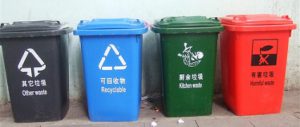Only a small proportion of people in China’s low-carbon pilot cities are living “low-carbon lives” in spite of widespread knowledge of the green agenda, a year-long survey of household energy consumption carried out by Beijing-based NGO Green Beagle suggests.
The study of habits in eight Chinese cities identified as green leaders by China’s top economic planning body, the National Development and Reform Commission, involved 3,200 questionnaires and interviews with three to five households in different income brackets in each region. The NGO wanted to find out if inhabitants of these places had heard about “low-carbon” lifestyles and whether they were making efforts to reduce their own environmental footprint through their daily choices.
Under the “low-carbon” pilot scheme, which launched in 2010, the eight cities – Tianjin, Chongqing, Shenzhen, Xiamen, Hangzhou, Nanchang, Guiyang and Baoding – are trying to find ways of reducing carbon emissions while continuing to grow economically (Beijing and Shanghai were added to the list in 2011, but are treated as a separate category). Five provinces are charged with the same task: Guangdong, Liaoning, Hubei, Shanxi and Yunnan. If they perform well, they will be treated as an example for the rest of the country.
Green Beagle found that public knowledge of the low-carbon agenda and the green actions people can take is already widespread in these cities thanks to television coverage, advertising campaigns, internet forums and print media. Almost 99% of respondents had heard about climate-change and were aware of the concept of a low-carbon lifestyle.
But, while most respondents had heard about “low-carbon” ideas, and some expressed support for the principle of reducing their cities’ carbon emissions, only a minority were implementing these ideals. Out of 135 people polled in Tianjin, only 10 said they would avoid buying a car for the sake of protecting the environment, for example. Of respondents who already owned a car, 62% said they use it for daily life and 31% for long-distance journeys.
Household energy use was – unsurprisingly – closely correlated with income, social status and local energy supply. An average settled family in a southern coastal city, for example, was found to have between four and six air-conditioning units, all set to 26 degrees, while a migrant worker in the same city had none. Some families said they could afford to jet overseas for a high-carbon holiday, while others reported that time off alone is a luxury and they have little opportunity to travel.
The researchers also noted a disparity between the awareness of the low-carbon agenda of different groups: average wage earners have no alternative to cheap public transport, but do not consider it a low-carbon choice. White collar workers, meanwhile, said they tend to travel by car, as it is convenient or necessary for their work, even though they know it is not low-carbon.
Green Beagle’s report is the latest addition to a growing literature on China’s energy-use patterns. Recent years have seen a string of studies come out about the structural difference in energy use across Chinese households, from researchers including Zhi Jing of the Chinese Academy of Sciences. Between the early 1980s and late 1990s, the percentage of energy sourced in the countryside being consumed by rural households (as opposed to servicing the cities) fell from 80.3% to 50%. Meanwhile, the overall contribution of biomass to household energy supplies fell from around 80% to 70%, while electricity and coal use increased. But rural energy use is limited by economic factors, and the energy structure changes quite slowly. In comparison, transportation and housing account for most of the energy consumption of urban dwellers.
In China’s reform era, uneven economic development has also created something of a north-south divide in energy consumption. In the economically developed south, gas and electricity came into use early and spread quickly – by 1996, electricity was common in the villages of Jiangsu and other southern provinces, while in northern herding areas, most rural household consumption was still for the sake of survival.
The huge differences across regions are still reflected in the types and quantities of energy consumed energy. Low-carbon advocacy should take this into account, while targeted energy-saving measures are needed from government.
Energy consumption habits have an impact on the environment, mostly determined by the type of energy used. Rural households mostly get their energy from biomass. Between 1991 and 2008, carbon emissions from Chinese agriculture rose by an average of 2.59% annually and accounted for 10.43% of total emissions. More than 90% of those emissions were due to the burning of straw, which happens largely to provide household energy. This kind of energy use creates huge carbon emissions, damages the land’s ability to recover, and results in the loss of soil, water and fertility.
In the cities, energy sources are more diverse. Electricity, coal and natural gas are used in the home, while transportation is powered by diesel, petrol and natural gas. Every aspect of urban life uses energy and creates emissions. Individual energy use and efficiency is determined by factors like how frequently and for how long residents shower, what they eat, how they travel, how they entertain themselves, how they work and so on. Wasting food, electricity and water damages the interests of all and, over time, has an irreversible impact on the environment. In the two decades from 1979 to 1999, the carbon footprint of food eaten in Beijing households increased by 28.5% as consumption of meat, which is carbon-intensive to produce, soared, supplementing or replacing grains.
Green Beagle also drew attention to the “lock-in effect”. Once large items of equipment and infrastructure are in place, the associated energy sources and efficiencies will remain fixed. A neighbourhood’s energy supply will also determine what kind of fuel households use, meaning that any attempt to build a low-carbon community has to be closely integrated with urban planning, the authors of the study said. Meanwhile, huge amounts of energy are consumed in the manufacture of everyday goods, and there is a real need for energy-saving and emissions-reduction in factories, at the same time as insulating low-income families from extra costs.
The external environment will of course influence consumption habits. With most external environmental factors – resource availability, level of economic development, energy and technology prices, market conditions, environmental policy – the government must take the lead.
The Green Beagle survey shows that, in the face of social norms and everyday inconveniences, individuals find it hard to change their habits – they don’t see the impact of their choices and often feel powerless and isolated. This suggests that a top-down, policy-led approach is suitable for reforming household energy use. Appropriate economic levers can be applied to encourage low-carbon choices, with subsidies or awards for low-income, low-carbon families and high-income, high-carbon families subject to some type of carbon tax to rein in their consumption.
At community level, green offices, organic markets and low-carbon advocacy can all increase monitoring and supervision within communities and increase the sense of achievement for those who manage to live low-carbon lives.
Zhang Chun is an intern at chinadialgue and Wang Haotong a Beijing-based journalist.
Homepage image by http2007






